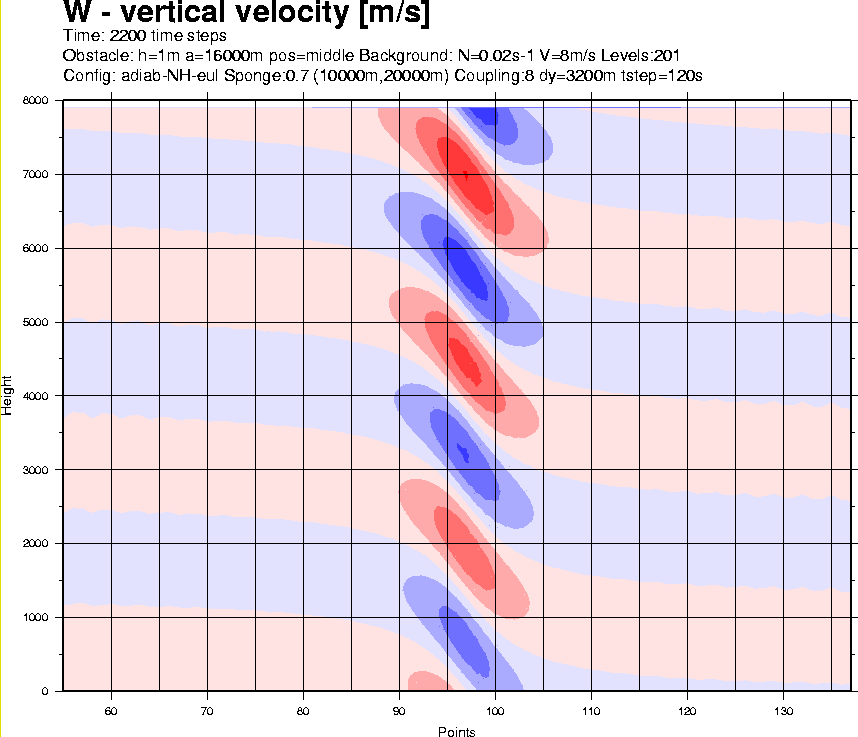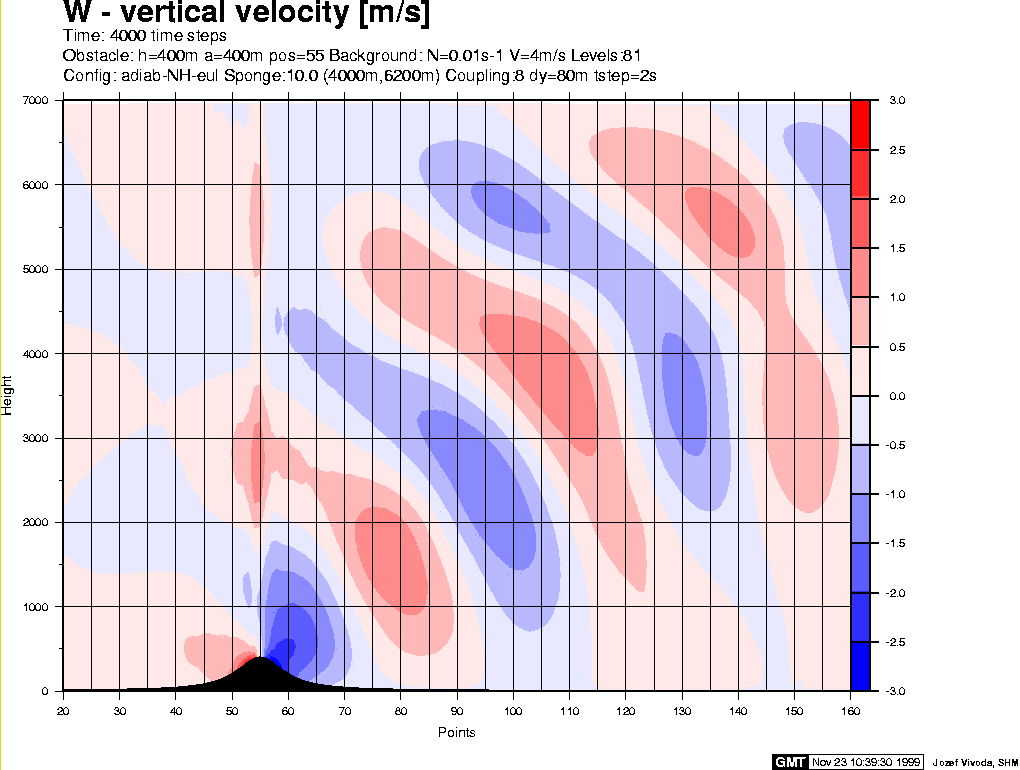
(more details vivoda++at++synoptik.shmu.sk)
There was need to introduce 2d-plane version of ALADIN. There were a few objectives for this:
The (y,z) 2d plane model has been developed in Toulouse during the summer 1999 and model changes have been phased into CY21 and according to references the 2d plane model is working properly now.
To run 2d plane model it is necessary to do:
Correct cycles of model can be fetched from Toulouse whenever it is necessary and we will not discuss this point here.
To prepare initial conditions and LBCs you need to run the program ACADFA(ACADemical FA file).
This program allows you to prepare idealized flow regimes characterized by constant wind, dry atmosphere, temperature profile defined by constant Brunt Vaisala frequency (BVF), constant pressure at mean sea level and Agnesi shape obstacle. Height and half width of obstacle together with BVF and wind speed define the character of the regime (hydrostatic or nonhydrostatic regime, linear or nonlinear regime). The initial filed is hydrostatically balanced.
There is not too much that has to be set in the namelist to run 2d model once you have initial conditions and LBCs. You have to set the following variables in the namelist:
Previous switches have to be set to get reasonable results from technical point of view. Next switches are more scientific and they are from new namelist NAMPONG and they define characteristics of sponge. This sponge was introduced to solve the problem of waves reflecting from model top.
The model variables are coupled with the background variables (RT00,RV00,RTB00) during the model execution exactly in the same way as it is done in the lateral coupling case. The background variables are usually equal to the initial conditions. The weight function is fully defined by REPONCO,REPONTP and REPONBT. Vertical velocity is coupled with zero in the case of nonhydrostatic model run rather than pseudovertical divergence. Pressure departure is coupled with zero also for nonhydrostatic run.
To perform diagnostics, a new tool has been developed. This tool allows you to calculate true vertical velocity (in m/s) on model levels, vertical momentum flux at constant height levels and surface drag.
Input to this program is the ICMSH file directly. Any new calculation could be easily added into this program.
We tried to repeat idealized simulations which can be found in (Bubnova, 1995). We have focused on two regimes:
Both regimes have been tested with eulerian, semi-lagrangian 3-time level and semi lagrangian two-time level. Nonhydrostatic version of the model has been initialized using (LNHDYN=3D.TRUE.) for all experiments.
Model setting was as follows:
Result after 2200 time steps are presented on figure 1.

Figure.1. Vertical velocity perturbation after 2200 time step for linear hydrostatic flow regime. Test has been performed with eulerian advection scheme and nonhydrostatic model version.
Model setting was following:
Result after 4000 time steps are presented on figure 2.

Figure 2. Vertical velocity perturbation after 4000 time step for nonlinear nonhydrostatic flow regime. Test has been performed with semilagrangian three time level advection scheme and nonhydrostatic model version.
If someone wishes to run ALADIN with more than 100 or even more than 200 vertical levels, he (she) has to carry out the following steps (valid for CY21T1/AL11). These steps are a redefinition of parameters used to define the size of statically allocated variables (variables are set to 300 for example):
This is a general list. Default values in the operational model are 100 for facomp.h and 200 for the rest of changed parameters.
Then all routines dependent on previous modules and includes have to be recompiled etc...
There are troubles to get good initial condition for nonlinear nonhydrostatic regime using ACADFA. The solution we currently get from file prepared by ACADFA is not analytical. Results presented here for the nonlinear non-hydrostatic regime have been reached using initial conditions prepared by R.Bubnova in 1995. So, first thing we have to solve is correction of this ACADFA shortcoming.
Next plan is to use 2d-plane version to stabilize 2-time level semi-lagrangian scheme for the non-hydrostatic version of ALADIN. This is pretty important in order to prepare conditions for operational running of non-hydrostatic ALADIN.
All programs mentioned here are available. It is enough to contact vivoda++at++synoptik.shmu.sk
 |
Home |